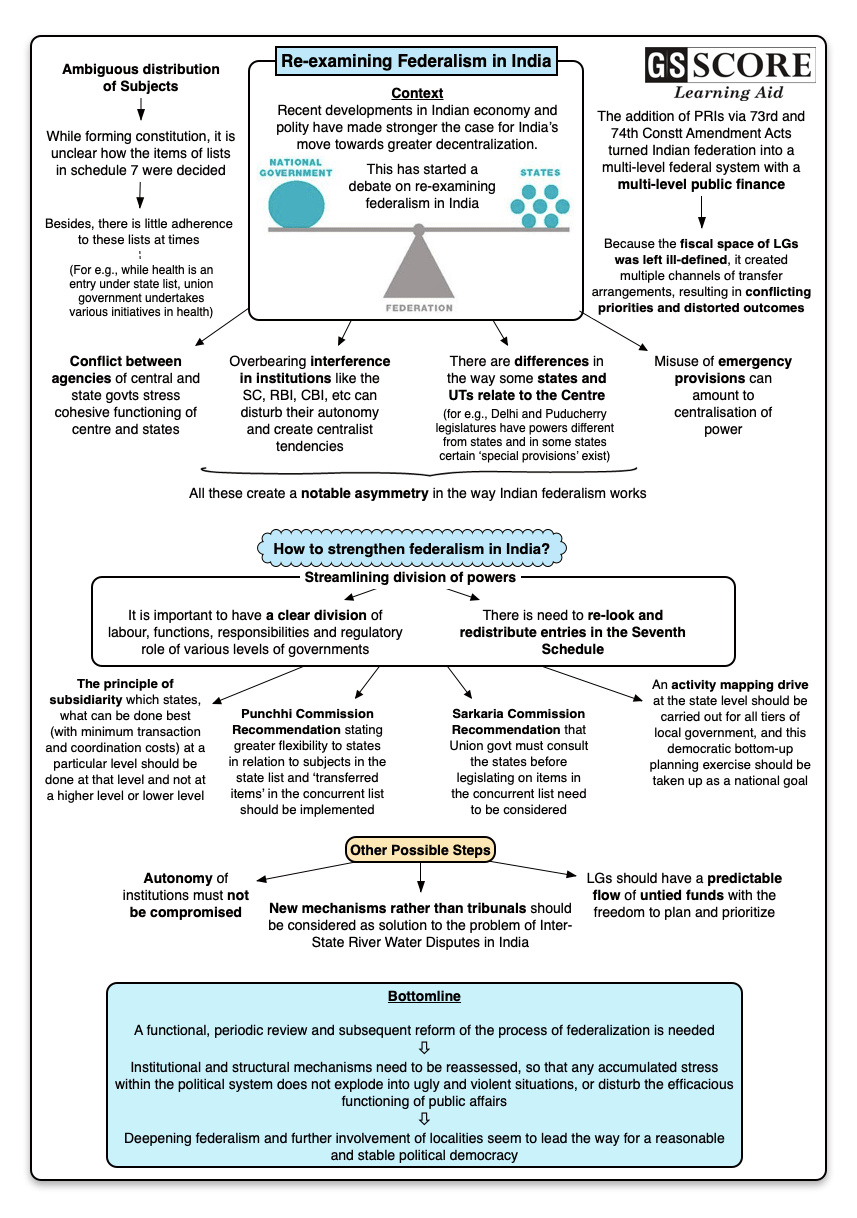

Recent developments in Indian economy and polity have made stronger the case for India’s move towards greater decentralization. This has started a debate on re-examining federalism in India.
Issue
Context
Recent developments in Indian economy and polity have made stronger the case for India’s move towards greater decentralization. This has started a debate on re-examining federalism in India.
Background:
|
Basis of Indian Federalism:
|
Analysis
- Today, in a liberalized environment, the ideological position behind a case for federalism is different than what it was at the time of independence.
- Globalisation process has generated a phase of ‘competitive federalism’, where provincial governments compete among themselves, and with the centre, to attract investment, capital and technology. New concepts of federalism like ‘cooperative federalism’ have also evolved.
- It is important to choose the right model of federalism as suiting the new times and age, because, the mal-functioning of federal structure, can even give rise to secessionist, inter-state, border-related, ethnic and nationalistic strife.
Fault lines in the Indian model of Federalism:
- Ambiguity in distribution of Subjects:
- At the time of making of the constitution there was no guiding principle that clarified the position as to why an item was placed in the Union, concurrent or state lists.
- And once the item was placed under a list, there has been little adherence to it. For example, while health is an entry under state list, union government undertakes various initiatives in health.
- Multi-layered character of the Local Governments (LGs):
- The 73rd and 74th amendments which were essentially meant to deepen federalism in India, added three tiers of Panchayati Raj Institutions- Gram Sabha (village level), Mandal Parishad (block level), Zila Parishad (district level). This turned Indian federation into a multi-level federal system with a multi-level public ?nance.
- Because the ?scal space of LGs was left ill-de?ned, it created multiple channels of transfer arrangements, resulting in conflicting priorities and distorted outcomes.
- Tussles between the agencies:
- Conflict between agencies of central government and state government stress cohesive functioning of centre and states.
- For example, states often do not allow smooth functioning of central investigation agencies within their states.
- Institutions like the Supreme Court, RBI, CBI, Election Commission, and academic institutions are pillars of the republic. Overbearing interference in their functioning can disturb their autonomy and create centralist tendencies.
- Existence of emergency provisions in the constitution, though placed as a safeguard, if misused, can amount to centralisation of power.
- Differences in the way some states and union territories relate to the Centre:
- Some Union Territories have legislature (Delhi and Pondicherry) while others don’t.
- Unlike any other, Pondicherry despite being a single administrative unit, is ‘non-contiguous’.
- Delhi has three further exceptions: police, land and public order are outside its purview.
- ‘Special provisions’ empower some state Governors to discharge some special responsibilities (Maharashtra, Gujarat, Manipur, Nagaland, Sikkim and Arunachal Pradesh).
- This creates a notable asymmetry in the way Indian federalism works.
- Another case in point is that of community resources like water. Role given by the Constitution to the Centre in regard to inter-state rivers has not been made much use of to devise effective conflict?resolution mechanisms.
How to strengthen federalism in India?
- It is important to have a clear division of labour, functions, responsibilities and regulatory role of various levels of governments.
- There is need to re-look and redistribute entries in the Seventh Schedule.
- The principle of subsidiarity can be used as a relevant guiding principle Which states, what can be done best (with minimum transaction and coordination costs) at a particular level should be done at that level and not at a higher level or lower level. This approach could be the most optimal.
- Sarkaria Commission Recommendation: Union government must consult the states before legislating on items in the concurrent list.
- Punchhi Commission Recommendation: Greater flexibility to states in relation to subjects in the state list and ‘transferred items’ in the concurrent list.
- LGs should have a predictable ?ow of untied funds with the freedom to plan and prioritize. It is also important to incentivize LGs to mobilise their own source revenue, like, property tax.
- Lessons can be learnt from Kerala which realised the operational dif?culties in 73rd/74th amendments, and tried to disaggregate the subjects given under schedules XI and XII into activities and sub-activities.
- An activity mapping drive at the state level should be carried out for all tiers of local government, and this democratic bottom-up planning exercise should be taken up as a national goal.
- Autonomy of institutions must not be compromised.
- New mechanisms rather than tribunals should be considered as solution to the problem of Inter-State River Water Disputes in India. Focus should shift from Conflict Resolution to Enabling Cooperation.
Conclusion
A functional, periodic review and subsequent reform of the process of federalization is needed. Institutional and structural mechanisms needed to be reassessed, so that any accumulated stress within the political system does not explode into ugly and violent situations, or disturb the ef?cacious functioning of public affairs. Deepening federalism and further involvement of localities seem to lead the way for a reasonable and stable political democracy.
Learning Aid


